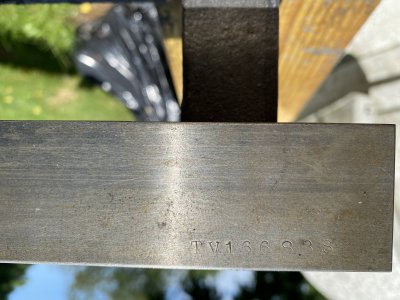- Joined
- Dec 25, 2011
- Messages
- 10,507
I have added a field to the Atlas Machines database for the location of the model and serial numbers. The database is in Downloads, although the copy currently there does not have the field (because only two records have anything entered in the new field. There is also a copy of the database in the sticky area of this Forum although that copy may not currently be up to date.
In any case, will everyone with one or more Atlas built machines listed in the database please report serial number (so that I can find it and including any prefix and /or suffix letters and/or numbers) and location of it and if separate, the data plate. Preferred method of reporting would be a PM sent to wa5cab with one or two photos. But text-only is also OK. AFAIK, the two possibilities for the lathes are:
(1) Aluminum or plastic data plate with Atlas or Craftsman and possibly other info printed on it and with model number stamped on it attached with two round-head drive screws near the center of the rear of the bed. Serial number and any prefix/suffix letters and/or numbers stamped into the top of the front way near the right end. If possible, note whether of not the drive screw holes are drilled through.
(2) Aluminum or plastic data plate with Atlas or Craftsman and possibly other info printed on it and with model number and serial number stamped on it, mounted by two round head drive screws on the right end of the bed. If possible, note whether of not the drive screw holes are drilled through.
For other machines, I am not sure what the possibilities are.
In any case, will everyone with one or more Atlas built machines listed in the database please report serial number (so that I can find it and including any prefix and /or suffix letters and/or numbers) and location of it and if separate, the data plate. Preferred method of reporting would be a PM sent to wa5cab with one or two photos. But text-only is also OK. AFAIK, the two possibilities for the lathes are:
(1) Aluminum or plastic data plate with Atlas or Craftsman and possibly other info printed on it and with model number stamped on it attached with two round-head drive screws near the center of the rear of the bed. Serial number and any prefix/suffix letters and/or numbers stamped into the top of the front way near the right end. If possible, note whether of not the drive screw holes are drilled through.
(2) Aluminum or plastic data plate with Atlas or Craftsman and possibly other info printed on it and with model number and serial number stamped on it, mounted by two round head drive screws on the right end of the bed. If possible, note whether of not the drive screw holes are drilled through.
For other machines, I am not sure what the possibilities are.


